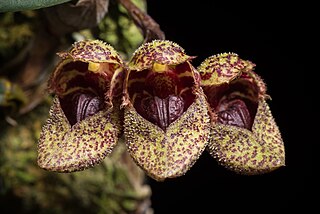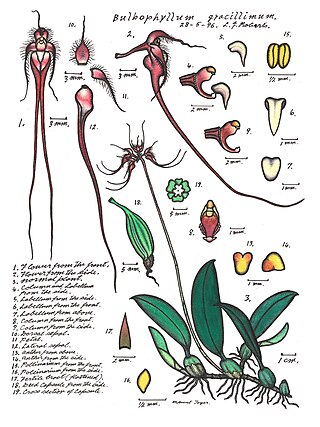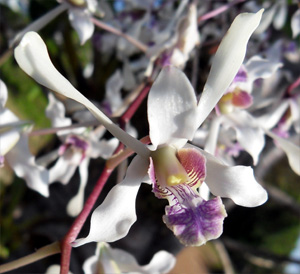
Bulbophyllum is a genus of mostly epiphytic and lithophytic orchids in the family Orchidaceae. It is the largest genus in the orchid family and one of the largest genera of flowering plants with more than 2,000 species, exceeded in number only by Astragalus. These orchids are found in diverse habitats throughout most of the warmer parts of the world including Africa, southern Asia, Latin America, the West Indies, and various islands in the Indian and Pacific Oceans. Orchids in this genus have thread-like or fibrous roots that creep over the surface of trees or rocks or hang from branches. The stem is divided into a rhizome and a pseudobulb, a feature that distinguished this genus from Dendrobium. There is usually only a single leaf at the top of the pseudobulb and from one to many flowers are arranged along an unbranched flowering stem that arises from the base of the pseudobulb. Several attempts have been made to separate Bulbophyllum into smaller genera, but most have not been accepted by the World Checklist of Selected Plant Families.
Bulbophyllum tokioi is a species of plant in the family Orchidaceae. It is endemic to Taiwan. It was described in 1935 by Noriaki Fukuyama.

Bulbophyllum frostii, commonly known as Frost's bulbophyllum or Dutchman's shoes is a species of orchid, In the wild it grows as an epiphyte, inhabiting evergreen seasonal lowland rainforests in Vietnam and more rarely in Thailand, including the Malay peninsula. It was more recently reported growing in the Yunnan province of China during a series of botanical surveys between 2017 and 2020. This plant is usually found at elevations of around 1500m above sea level.

Dendrobium discolor, commonly known as antler orchid or golden orchid, is a species of epiphytic or lithophytic orchid in the family Orchidaceae, and are native to northern Australia, New Guinea, and part of Indonesia. It has cylindrical pseudobulbs, each with between ten and thirty five leathery leaves, and flowering stems with up to forty mostly brownish or greenish flowers with wavy and twisted sepals and petals.

Eulophia guineensis is a species of orchid. It is the type species of the genus Eulophia and is commonly known as the Guinea Eulophia or the broad-Leaved ground orchid. It is found in the Cape Verde Islands, much of tropical Africa and part of the Arabian Peninsula. It is a terrestrial orchid that can grow to a metre or so tall, and is found in lowland and upland woods and scrubland.

Bulbophyllum arfakianum is a species of orchid in the genus Bulbophyllum. This rare orchid is endemic to Arfak Mountains at elevations 50~400 meters in rainforests, Papua New Guinea.

Bulbophyllum baileyi, commonly known as the fruit fly orchid, is a species of epiphytic or lithophytic orchid that is native to Queensland and New Guinea. It has coarse, creeping rhizomes, curved, yellowish pseudobulbs with a single thick, fleshy leaf, and a single cream-coloured flower with yellow, red or purple spots. It grows on trees and rocks in open forest, often in exposed places.

Bulbophyllum lepidum, is a species of orchid, in the subfamily Epidendroideae and the genus Bulbophyllum, with the common name: Venus' fan bulbophyllum.

Bulbophyllum gracillimum, commonly known as the wispy umbrella orchid, is a species of epiphytic orchid. It has a creeping rhizome, widely spaced, olive green pseudobulbs, each with a single thick, leathery, fleshy leaf and between six and ten purplish red flowers spreading in a semicircular umbel. The flowers have distinctive long, thread-like tails on the lateral sepals. It has a wide distribution and is found in New Guinea, New Caledonia, Indonesia, Malaysia and part of tropical North Queensland.

Bulbophyllum grandimesense, commonly known as the pale rope orchid, is a species of epiphytic orchid with well-spaced pseudobulbs and brown bracts arranged along the stems. Each pseudobulb has a single, fleshy, dark green leaf and usually only a single white flower with thread-like tips on the sepals. It grows on rainforest trees in a small area of tropical North Queensland.
Bulbophyllum johnsonii, commonly known as the yellow snake orchid, is a species of epiphytic or lithophytic orchid that has a thin, creeping rhizome with flattened pseudobulbs, each with a single tough, dark green leaf and a single bright yellow to orange flower on a thread-like stalk. It grows on trees, shrubs and rocks in and near rainforest in tropical North Queensland.
Bulbophyllum lamingtonense, commonly known as the cream rope orchid, is a species of epiphytic or lithophytic orchid with well-spaced pseudobulbs and brown bracts arranged along the stems. Each pseudobulb has a single, fleshy, channelled leaf and a single cream-coloured or white flower with yellow tips. It grows on trees and rocks near cliffs and the edge of rainforest near the eastern border between New South Wales and Queensland.
Bulbophyllum lewisense, commonly known as the Mount Lewis rope orchid, is a species of epiphytic orchid with pseudobulbs and pale brown bracts arranged along the stems. Each pseudobulb has a single, dark green, channelled leaf and a single white flower with pointed tips on the sepals. It grows on the higher branches of rainforest trees, often where it is exposed to breezes on the higher tablelands of tropical North Queensland.

Bulbophyllum longiflorum, commonly known as the pale umbrella orchid, is a species of epiphytic or lithophytic orchid. It has a creeping rhizome, widely spaced, dark green pseudobulbs with a single large, fleshy leaf, and flowers spreading in a semicircular umbel, resembling one-half of an umbrella. The flowers are canoe-shaped, greenish cream-coloured to yellowish with purple dots. It has a wide distribution and is found in parts of Africa, on islands in the Indian and Pacific Oceans, Southeast Asia, New Guinea and northern Australia.
Bulbophyllum montense is a species of orchid in the genus Bulbophyllum found in Borneo.
Bulbophyllum radicans, commonly known as the striped pyjama orchid, is a species of epiphytic or lithophytic orchid with long, hanging stems with roots near the base and covered with brown, papery bracts which partially hide the pseudobulbs. Each pseudobulb has a single thin leaf. A single small pink, cream-coloured or yellow flower with red or purplish stripes is borne on a thin flowering stem that emerges from the base of the pseudobulb. This orchid grows on trees or rocks in or near rainforest in tropical North Queensland.
Bulbophyllum xanthornis is a species of orchid in the genus Bulbophyllum.

Dendrobium lineale is a species of orchid. It is an epiphytic plant that grows along the north-eastern coast of New Guinea, from Milne Bay to just over the border into the Indonesian Province of Papua, and from sea level to around 800 metres (2,600 ft). It has cane-like pseudobulbs which grow up to 2 metres long and 2–3 centimetres (0.8–1.2 in) in diameter. Its inflorescences are up to 75 cm (30 in) long with many flowers, up to 5 cm (2.0 in) across. Its leaves are oblong or lanceolate, and up to 15 cm (6 in) long. They last two to three months and bloom throughout the year in the native habitat.

Bulbophyllum maxillare, commonly known as the red horntail orchid, is a species of epiphytic orchid with tapered grooved, dark green to yellowish pseudobulbs, each with a single large, thin leaf and a single reddish flower with yellow or white edges. The lateral sepals are much larger than the dorsal sepal which in turn is much larger than the petals. It grows on the lower branches of rainforest trees in India, New Guinea and tropical North Queensland.
Bulbophyllum amorosoanum is a species of orchid in the genus Bulbophyllum found in Bukidnon, Mindanao, Philippines.












